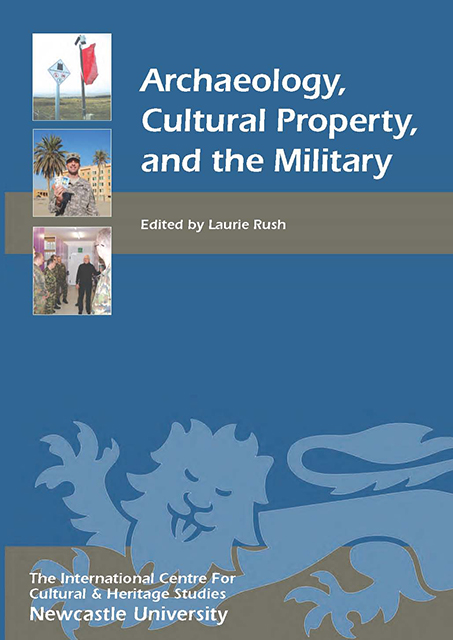Book contents
- Frontmatter
- Contents
- List of Illustrations: Figures and Tables
- Archaeology and the Military: An Introduction
- 1 The Obligations Contained in International Treaties of Armed Forces to Protect Cultural Heritage in Times of Armed Conflict
- 2 Rescuing Europe’s Cultural Heritage: The Role of the Allied Monuments Officers in World War II
- 3 The UK’s Training and Awareness Programme
- 4 US Army Civil Affairs: Protecting Cultural Property, Past and Future
- 5 Cultural Property Protection in the Event of Armed Conflict: Deploying Military Experts or Can White Men Sing the Blues?
- 6 Good Training and Good Practice: Protection of the Cultural Heritage on the UK Defence Training Estate
- 7 In-Theatre Soldier Training through Cultural Heritage Playing Cards: A US Department of Defense Example
- 8 Dealing the Heritage Hand: Establishing a United States Department of Defense Cultural Property Protection Program for Global Operations
- 9 Teaching Cultural Property Protection in the Middle East: The Central Command Historical/Cultural Advisory Group and International Efforts
- 10 Cultural Resources Data for Heritage Protection in Contingency Operations
- 11 Time not on my Side: Cultural Resource Management in Kirkuk, Iraq
- 12 US Military Support of Cultural Heritage Awareness and Preservation in Post-Conflict Iraq
- 13 Operation Heritage
- 14 Cultural Property Protection in the Event of Armed Conflict – Austrian Experiences
- 15 The Role of the Swiss Armed Forces in the Protection of Cultural Property
- 16 Preserving Global Heritage from Space in Times of War
- Appendix 1 1954 Hague Convention and its two Protocols
- Appendix 2 Author Biographies
- Index
10 - Cultural Resources Data for Heritage Protection in Contingency Operations
Published online by Cambridge University Press: 28 February 2023
- Frontmatter
- Contents
- List of Illustrations: Figures and Tables
- Archaeology and the Military: An Introduction
- 1 The Obligations Contained in International Treaties of Armed Forces to Protect Cultural Heritage in Times of Armed Conflict
- 2 Rescuing Europe’s Cultural Heritage: The Role of the Allied Monuments Officers in World War II
- 3 The UK’s Training and Awareness Programme
- 4 US Army Civil Affairs: Protecting Cultural Property, Past and Future
- 5 Cultural Property Protection in the Event of Armed Conflict: Deploying Military Experts or Can White Men Sing the Blues?
- 6 Good Training and Good Practice: Protection of the Cultural Heritage on the UK Defence Training Estate
- 7 In-Theatre Soldier Training through Cultural Heritage Playing Cards: A US Department of Defense Example
- 8 Dealing the Heritage Hand: Establishing a United States Department of Defense Cultural Property Protection Program for Global Operations
- 9 Teaching Cultural Property Protection in the Middle East: The Central Command Historical/Cultural Advisory Group and International Efforts
- 10 Cultural Resources Data for Heritage Protection in Contingency Operations
- 11 Time not on my Side: Cultural Resource Management in Kirkuk, Iraq
- 12 US Military Support of Cultural Heritage Awareness and Preservation in Post-Conflict Iraq
- 13 Operation Heritage
- 14 Cultural Property Protection in the Event of Armed Conflict – Austrian Experiences
- 15 The Role of the Swiss Armed Forces in the Protection of Cultural Property
- 16 Preserving Global Heritage from Space in Times of War
- Appendix 1 1954 Hague Convention and its two Protocols
- Appendix 2 Author Biographies
- Index
Summary
INTRODUCTION
As a key instrument of US foreign policy, the Department of Defense's (DoD) global reach since World War II has served to help maintain international peace, provide humanitarian and disaster assistance, improve infrastructure capacity in other nations and curb the spread of illegal international narcotics trafficking. In many such activities, military engineers and embedded teams of technical experts are often at the forefront of planning and initial placement of US personnel and material. Traditionally, few professional cultural resource specialists have been included in these efforts. In addition, information as to the presence and character of local heritage resources was absent from mission planning for the most part. This gap extended from the basic data itself to a general lack of standards and processes for employing the data in military planning for contingencies. In this chapter some past and current efforts by the US military to deal sensitively with cultural heritage during contingency operations are reviewed and potential improvements by the international community considered. The ultimate goal is to ensure that, for heritage or cultural property protection, the right data is available to the right people at the right time, before, during and after combat situations.
WORLD WAR II AND THE COLD WAR ERA
During World War II, the concerns of the US military and its allies with cultural heritage focused on art, architecture, museums and monuments. Well-known examples include the successful recovery of art looted by the Axis powers and the preservation of the architectural treasures of Paris and Rome from destruction by retreating forces (and see Spirydowicz, this volume). Less fortunate was the attempt to forestall the destruction of the glass and sculptural treasures of the Monte Cassino monastery during the Italian campaign, despite a long and hard look by the Allies at the direction of General Eisenhower.
In the succeeding Cold War era (1945–1991) US forces were stationed at bases around the world, implementing a policy of strategic containment of the Communist bloc. No formal guidelines existed at that time for the protection of cultural heritage sites by US personnel on these installations. Although the US had helped foster the creation of the 1954 Hague Convention for the Protection of Cultural Property in the Event of Armed Conflict, Cold War era concerns by the Pentagon forestalled its adoption by the US Senate.
- Type
- Chapter
- Information
- Archaeology, Cultural Property, and the Military , pp. 108 - 116Publisher: Boydell & BrewerPrint publication year: 2010
- 1
- Cited by



